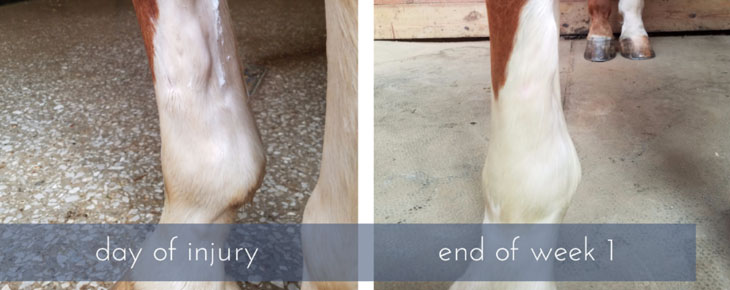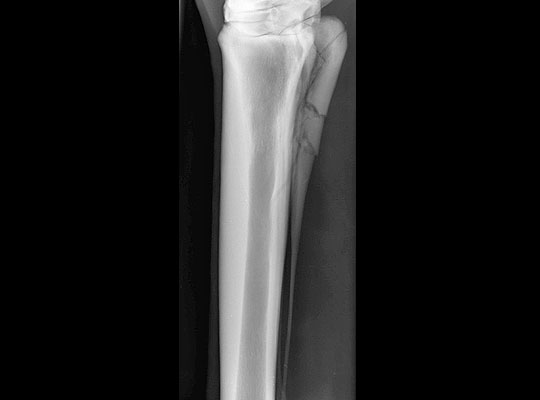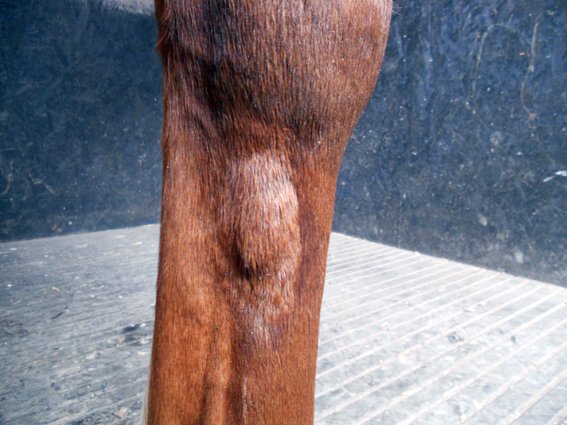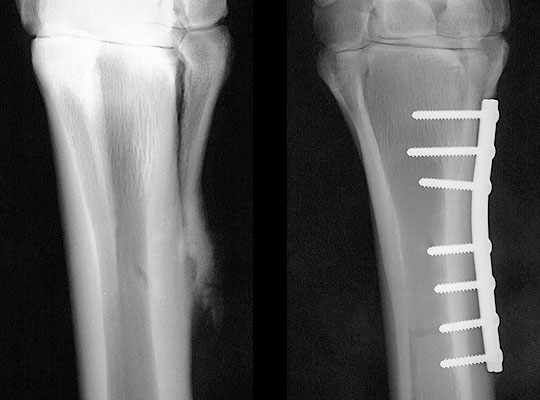
The fracture of a splint bone in the horse is a reasonably common occurrance. The splint bone plays an important role in the stability and support of the knees and hocks, therefore it is important that all fractures involving them are treated immediately.

Causes of Splint Bones Fractures:
Fractures of the bottom third of the splint bone are what is most common and they are usually the result of internal trauma by over extending the fetlock joint. This will occur when the affected leg is fully weight bearing and the fetlock is at its lowest point of the horses stride.
This results in stress being placed on the bone, between the attachments to the cannon bone at one end and the attachments to the fetlock at the other end. These fractures will usually occur in horses at around five to eight years of age when the splint bone has lost some flexibility.
Strain of the suspensory ligament will often occur hand in hand with these bottom third fractures because similar stress is being placed on the ligament.
Another possible way that the splint bone will break is when the suspensory strain will be what causes the splint bone to fracture as the injured suspensory ligament pushes the splint bones outwards during flexion of the fetlock.
Conformation, which can lead to interference – (where one limb strikes another during work) will predispose horses to fracture their inside splint bones. A excellent example are knocked kneeed horses where the limb angles outwards below the knee. Horses with unbalanced feet -where inside and outside hoof walls are different lengths – may be more likely to suffer lower splint fractures.
The Warning Signs Of Fracture:
There will be swelling over the inside and/or outside of the cannon bone, heat, pain to the touch and lameness and are all signs that a splint bone may have been fractured.
Simple fracture lameness isn’t always noticeable in a straight line trot, whereby lunging or faster work may be required to detect any lameness.
Diagnosing a fracture:
The signs of a fracture as described above will suggest a fracture may have occurred. X-rays will need to be taken to give a positive diagnosis of the injury.
An ultrasound scan should also be done to see if there is any suspensory ligament strain that occurred at the same time as the fracture of the bottom third of the splint bone.

Treatment Of The Injury:
If there is an obvious swelling of the leg when the initial injury occurs, place ice on the area for 15-20 minutes before placing a very well padded pressure bandage over the area until your vet can examine your horse.
Low fractures: The usual treatment for bottom third fractures is to surgically remove the broken bottom piece of bone and round off the end of the remaining portion. This is still the most preferred way of treating this type of fracture in most cases. This allows the horse to be back to work fairly quickly (if there is no suspensory injury) after surgery.
If the fractured portion of bone is not displaced and is stable, then stall rest along with a pressure bandage will heal the injury perfectly. Recovery period will be longer for the horse with this treatment.
Higher fractures: More complicated fractures that involve the upper third of the splint bone will require surgery to repair the top part of the splint bone in place so downwards pressure from the knee or hock does not cause continual movement of the splint bone – which causes irritation and increased lameness. This is achieved by using stainless steel screws (which affix the splint bone to the cannon bone) or sometimes a combination of screws along with a steel plate.
If there is an open wound over the fractured area, the wound and bone often become infected therefore treatment with antibiotics and antibiotic dressings are necessary to control the infection before any surgery can take place. Given the proper amount of time, these fractures could possibly heal themselves and surgery may not be necessary.

The Recovery Rate:
After treatment is completed, the chances of your horse returning to their previous level of work once is usually very good. If the suspensory ligament has also been strained, then the period off of work will be much longer (possibly many months) and there is a higher likelihood of lameness reoccurring to the suspensory ligament.
When starting a horse back to work again their exercise needs to be built up gradually – starting with just walking twice a day and slowly working up from there.
Points Of Action:
If you do suspect your horse has a fractured splint bone, then follow this simple procedure: